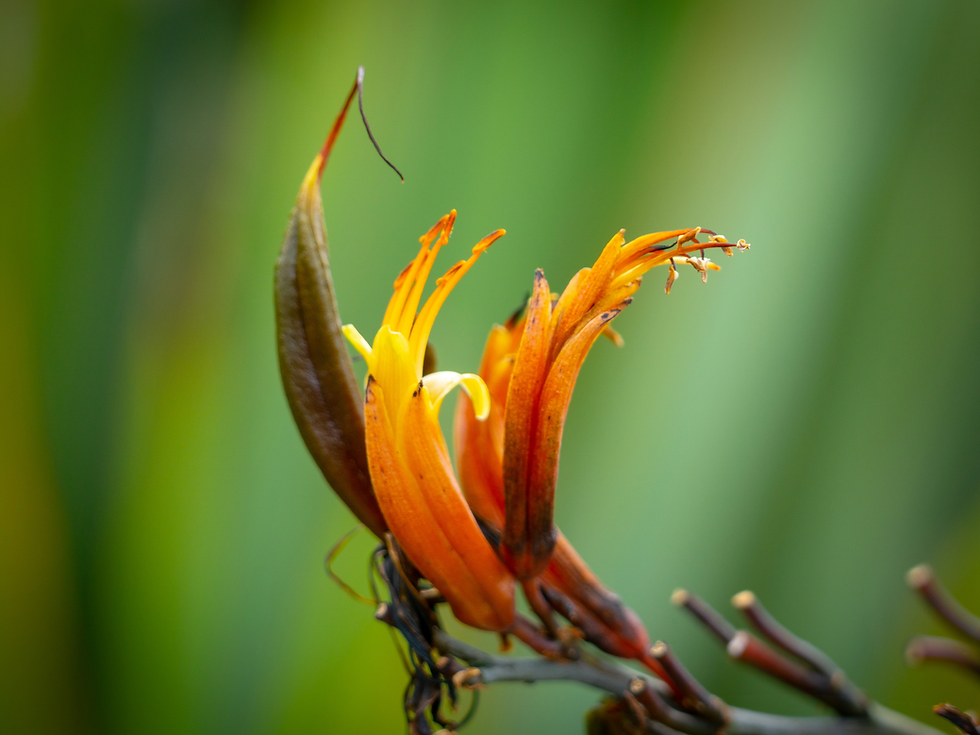The Top 5 Mistakes People Make When Planting Natives - and How to Avoid Them
- Nadia Crighton
- Jul 14
- 4 min read

Planting native species in your garden or restoration project is a wonderful step toward supporting Aotearoa’s unique ecosystems. But even with the best intentions, New Zealanders can easily make common errors that can undermine success. But not to worry Native Restorations is at hand to help you avoid these five mistakes to create a thriving, resilient native planting that truly stands the test of time.
1. Choosing the Wrong Plant for Your Site
Mistake: Selecting native plants without considering local conditions—soil type, drainage, sunlight, or exposure.
Why it fails: Each species has specific environmental requirements. Ignoring them leads to poor growth or loss.
How to Fix:
Assess your site (full sun, shade, wind exposure, moisture).
Consult local experts (like Native Restorations) or your local council’s “plant for your ecosystem” resources.
Match species to site conditions—for example, Kōwhai near water edges, Red Mātipo in drier areas.
#Fun Fact: Red Mātipo (Myrsine australis) is a resilient and fast-growing native tree that performs well in drier parts of New Zealand. Known for its toughness, it can handle frosts, lower rainfall, and a range of light conditions—from full sun to partial shade. Red Matipo is a popular choice for revegetation and riparian restoration projects, and once established, it can even grow successfully beneath canopies.
2. Ignoring Mature Size & Spacing for Planting Natives
Mistake: Planting too many specimens too closely, or forgetting to plan for mature height.
Why it fails: Small gardens can get crowded, while oversize plants may need early removal or trimming.
How to Fix:
Check tags or NZ plant descriptions for mature dimensions (height/width of Kōwhai, Mānuka, etc.).
Leave adequate space—allow 1–2 metres for small shrubs, 3–5 metres for large trees. This avoids crowding and helps create healthy, mature plant structures.
#Fun Fact: The ideal spacing for Mānuka depends on your planting goals. For dense screens or hedging, place plants approximately 1 to 1.5 metres apart. If you're aiming for a more natural, open look with individual feature plants, increase spacing to 2 to 3 metres. In commercial settings, Mānuka is commonly planted at 3m x 3m intervals, resulting in approximately 1,100 plants per hectare.

3. Failing to Remove Weeds & Competing Growth
Mistake: Planting natives in existing grass, weeds, or invasive weed competition.
Why it fails: Natives struggle to establish roots when competing with aggressive weeds.
How to Fix:
Clear the site thoroughly—remove weeds, grasses, and invasive species first.
Use selective herbicides when necessary, following manufactures guidelines.
Add a 2–3 cm mulch layer to suppress regrowth without suffocating natives.
#Fun Fact: Mulching offers a range of benefits that can dramatically improve the health and resilience of your native garden. It helps retain soil moisture by slowing evaporation, which is especially important in New Zealand’s drier regions, reducing the need for frequent watering and lowering water costs. At the same time, mulch acts as a natural weed suppressant, blocking sunlight and stopping weed seeds from germinating—minimising competition for water, nutrients, and sunlight while keeping pest plants at bay. It also insulates the soil, regulating temperature by keeping roots cooler in summer and warmer in winter, protecting plants from extreme conditions. A consistent mulching routine throughout the year will help your native plants thrive, save you time on maintenance, and keep your garden looking its best.
4. Using Root-Bound or Balled Stock Incorrectly
Mistake: Planting pots or rootballs without preparing the roots.
Why it fails: Roots continue circling, limiting growth and stability.
How to Fix:
Divide circling roots with a sharp knife or cut an “X” at the base.
Remove any burlap or synthetic wrap from B&B stock.
Plant so the root flare is slightly above ground level, not buried.
#Fun Fact – Some natives do well in pots; however, it is vital to check for root-bound issues. A root-bound plant occurs when the roots have outgrown their pot, becoming tightly packed and often circling around the interior, which can limit healthy growth and overall vitality. Signs of a root-bound native plant include roots visibly protruding from drainage holes, or spiraling densely when the plant is removed from its container. Other indicators are stunted or unusually slow growth, leaves that appear smaller, yellowing, or browning due to reduced access to nutrients and water. In more extreme cases, the pressure from the roots can cause the pot to warp or crack. Recognising these symptoms early is key to maintaining a healthy native plant.

5. Starting Too Late & Skimping on Preparation
Mistake: Not planning ahead—leading to rushed planting or unavailable species.
Why it fails: Native stock is often limited; poor prep leads to high failure rates.
How to Fix:
Plan 12–24 months ahead for shrubs and trees to secure quality eco-sourced plants.
Prepare the site in advance: fencing, weed control, and soil improvement.
For larger populations, consider direct seeding with support of local native-seed guidelines.
Be Picky About 'Native' vs 'Introduced' Lookalikes
Mistake: Buying plants that look local but aren’t—potentially invasive outside their natural range.
Example: Taupata, Pōhutukawa, and Harakeke are invaluable in some regions—but problematic in others .
Fix:
Use local council or DOC resources to confirm species suitability.
Buy from reputable native plant nurseries with provenance assurance.
#We Love Natives!
Native planting is a powerful way to connect with NZ’s unique environment—but success hinges on careful planning. By matching plants to the site, preparing soil, managing competition, and pacing your project, you’ll create a beautiful and sustainable native space.
At Native Restorations, we’re dedicated to helping homeowners and communities restore New Zealand back to life. Looking for personalised advice, design support, or quality local plant stock? Contact us today and let’s grow your vision together.




Comments